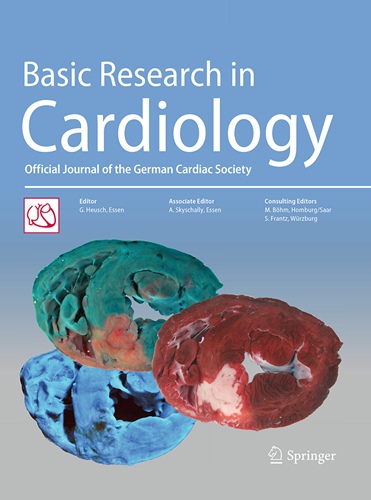抗菌肽CRAMP/LL-37通过抑制组织蛋白酶L介导心肌细胞对铁下垂的抵抗。
IF 8
1区 医学
Q1 CARDIAC & CARDIOVASCULAR SYSTEMS
引用次数: 0
摘要
铁下垂是心肌细胞损失和心功能障碍的重要原因。抗菌肽相关抗菌肽(CRAMP)是一种内源性多肽,可调节机体氧化应激并参与铁凋亡。然而,其在铁下垂中的具体作用和机制尚不清楚。为了分析CRAMP在铁下垂中的作用,我们首先分析了其在梗死心肌组织中的表达,并通过过表达和敲低技术在体外验证了其在铁下垂中的作用。分析组织蛋白酶L (CTSL)的活性、表达及其对铁下垂的影响,验证CTSL是否作为CRAMP的下游参与铁下垂。利用数据库筛选CTSL蛋白二硫异构酶家族A成员4 (PDIA4)作为CTSL的相互作用蛋白,并通过基因敲低和过表达分析PDIA4在铁死亡中的作用。最后,通过小鼠心肌梗死模型验证了CRAMP对铁下垂的调节机制。心肌梗死组织和心肌细胞暴露于铁下垂诱导剂后,痉挛水平均降低。过表达CRAMP或预处理LL-37可减轻心肌细胞铁下垂,而敲低CRAMP则加重细胞死亡。在铁致应力作用下,CTSL表达升高。痉挛通过拮抗CTSL活性抑制铁下垂。CTSL活性和水平异常升高导致PDIA4降低。过表达PDIA4可抑制CTSL诱导的铁下垂,而下调PDIA4可抵消CRAMP的保护作用。在体内,CRAMP过表达和给药均可显著改善心肌损伤,改善心功能。痉挛通过抑制CTSL活性增加PDIA4水平,并拮抗心肌细胞的铁下垂。靶向CRAMP为心肌损伤的预防和管理提供了创新的治疗策略和见解。本文章由计算机程序翻译,如有差异,请以英文原文为准。
Antimicrobial peptide CRAMP/LL-37 mediates ferroptosis resistance in cardiomyocytes by inhibiting cathepsin L.
Ferroptosis is an important cause of cardiomyocyte loss and cardiac dysfunction. Cathelicidin-related antimicrobial peptide (CRAMP) is an endogenous polypeptide that regulates oxidative stress in the body and is involved in ferroptosis. However, its specific role and mechanism in ferroptosis are unclear. To analyze the role of CRAMP in ferroptosis, we first analyzed its expression in infarcted myocardial tissues, and verified its role in ferroptosis in vitro through overexpression and knock-down techniques. The activity and expression of cathepsin L (CTSL) and its effect on ferroptosis were analyzed to verify whether CTSL participated in ferroptosis as a downstream of CRAMP. Protein disulfide isomerase family A member 4 (PDIA4) was screened as an interacting protein of CTSL by using the database, and the role of PDIA4 in ferroptosis was analyzed by gene knockdown and overexpression. Finally, the regulatory mechanism of CRAMP in ferroptosis was verified in vivo by mouse myocardial infarction model. CRAMP levels were reduced in both infarcted cardiac tissues and cardiomyocytes exposed to ferroptosis inducers. The overexpression of CRAMP or pretreatment of LL-37 alleviated cardiomyocyte ferroptosis, whereas CRAMP knockdown exacerbated cell death. Under ferroptotic stress, the expression of CTSL was elevated. CRAMP inhibited ferroptosis by antagonizing the CTSL activity. Abnormal increase in CTSL activity and levels caused PDIA4 to decrease. Overexpression of PDIA4 inhibited ferroptosis induced by CTSL, while knocking down PDIA4 counteracted the protection of CRAMP. In vivo, both CRAMP overexpression and administration of CRAMP peptide significantly ameliorated myocardial injury and improved cardiac function. CRAMP increases PDIA4 levels by inhibiting the activity of CTSL and antagonizes ferroptosis in cardiomyocytes. Targeting CRAMP offers innovative therapeutic strategies and insights for the prevention and management of myocardial injury.
求助全文
通过发布文献求助,成功后即可免费获取论文全文。
去求助
来源期刊

Basic Research in Cardiology
医学-心血管系统
CiteScore
16.30
自引率
5.30%
发文量
54
审稿时长
6-12 weeks
期刊介绍:
Basic Research in Cardiology is an international journal for cardiovascular research. It provides a forum for original and review articles related to experimental cardiology that meet its stringent scientific standards.
Basic Research in Cardiology regularly receives articles from the fields of
- Molecular and Cellular Biology
- Biochemistry
- Biophysics
- Pharmacology
- Physiology and Pathology
- Clinical Cardiology
 求助内容:
求助内容: 应助结果提醒方式:
应助结果提醒方式:


